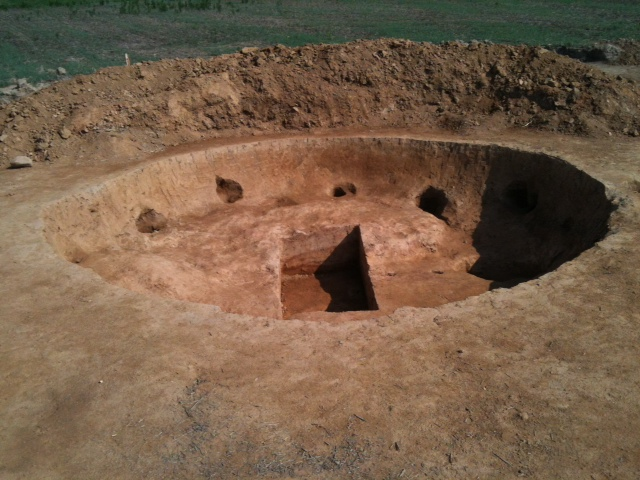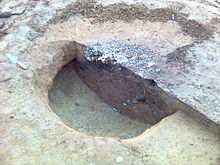Feature (archaeology)
One finding in the archaeological sense, the observable or measurable during an archaeological excavation of finds, that is, the fund context. These circumstances include, specifically the relationship between
- Archaeologically relevant finds with each other,
- Between these findings and the surrounding strata,
- Between the surrounding strata.
The find circumstances be photographically documented drawings and in text form. This documentation serves as the basis for the scientific processing and analysis of excavation in terms of constructability, because the finding is always destroyed by excavation.
Explaining the example of grave findings
To illustrate the example of Excavated grave - finding: the pit walls, pit backfilling, the skeleton and all offerings in a position in which they were exposed by the excavation, ie in situ ( Latin " out of place " ), are the findings. All mobile objects, i.e., the skeletal parts and the additions are moreover finds. The Degree of observation and documentation is very important because the situation of grave goods in the grave, or the position of the skeleton can be predictive for the temporal and cultural position of the lesion. The observations also allow statements about the time after the filling of the grave to, about whether the grave opened again and possibly has been robbed, or whether creatures such as hamsters have thwarted the layer sequence of the pit backfilling with their transitions; Such external influences are referred to as finding fault. External influences that alter the original state of the evidence, can be demonstrated to some extent also, about the Zerscherbung of pottery through the soil pressure or biking the surface, the decomposition of the soft tissue on the body or the infiltration of sediment into cavities such as a coffin. This fine sediment can fill the cavity, and trace its shape and is after the complete decay of the coffin remains often the only indication of a formerly existing coffin. As transitory almost all other organic materials are also. So the "story" of the tomb from the time of its excavation to excavation based on its properties ( layer sequence including disorders as well as the location of the finds) is understandable and the original state of the finding and its emergence partially reconstructed. However, the observation of these properties is only through excavation, ie by engaging in the finding possible - so the archaeologist destroys the findings. For this reason, the inclusion of finding properties by means of photographic techniques, technical drawings and textual descriptions is made very carefully.
Definitions
According to common sense prevailing on excavations all documentable and not readily movable objects are called findings, mostly it involves soil discoloration or wall remains. Thanks to modern technology, the " mobility " of the objects has been relativized, because by means of block recovery may well also all graves are transported without destroying the findings for themselves. In a broader sense, all burial sites or settlements can be regarded as a single finding that in several subordinate findings ( graves, pits, etc.) is divided. About this more or less tacitly accepted use of the term addition, however, several researchers have tried different approaches to a definition:
- After Manfred Eggert findings are the respective " totality historically meaningful observations in archaeological situations ." This definition is broad, but it is limited to the historical statement and displaced by the natural processes that are essential for finding reconstruction. According to Eggert will continue as "... finding primarily a whatever in detail beschaffenes, concretely perceptible ensemble of more or less clearly distinguishable discoloration of organic and inorganic, cultural and non-cultural influences, layer formation and layer disordering, out of shape, texture and consistency short, something empirically given, something delimitable and that's writeable by archaeological interest ... ", respectively. Eggert here focuses on the Recordable, including natural and human-induced influences and circumstances, however, restricts the amount of findings on soil characteristics ( discoloration ) that therefore he clings eg building structures (such as walls ) from.
- Colin Renfrew and Paul Bahn describe feature (English for findings) as follows: " A non -portable artifact, eg hearths, architectural elements, or soil stains. "translation ". A non- transportable, used / shaped by human object, such as stoves, architectural elements or soil discoloration " The definition remains vague and is limited only to the argument of transportability. The reasons given in the examples "architectural elements" are misleading, because including quite undeniably transportable items such as column capitals can be understood.









